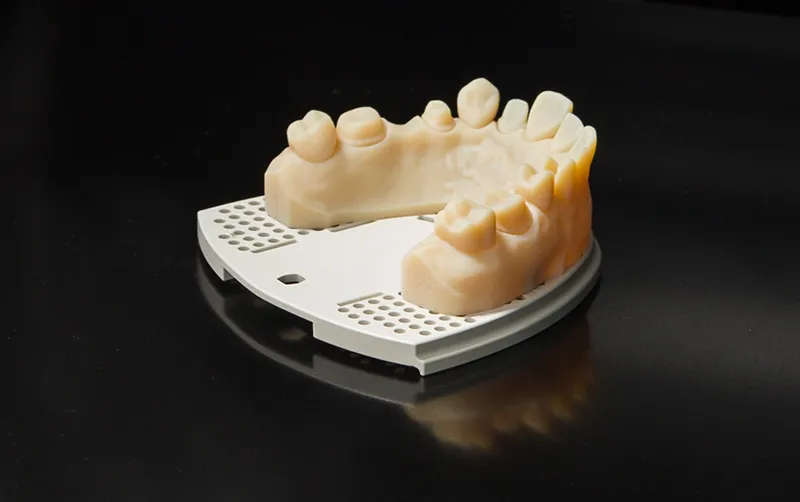In recent years, 3D printing has revolutionised different industries—and dentistry stands at the forefront of this transformative wave. This cutting-edge technology is reshaping how dental restorations, such as veneers, inlays, onlays, crowns, bridges, and implants, are designed and fabricated.
Employing digital scanning and computer-aided design (CAD), dentists can design and fabricate highly accurate restorations that closely match the patient’s existing teeth in shape, size and colour, resulting in a natural and durable aesthetic solution. Let’s discuss the science behind 3D printing, highlighting their precision and the advantages they offer to patients and dental practitioners.
The future of dentistry is here, and it’s 3D printed!
Imagine crafting a perfect smile, customised just for you. That’s the power of 3D printing in dentistry. This cutting-edge technology allows dentists to create highly precise and personalised dental restorations, orthodontic trays, tooth models, and surgical guides.
3D printing not only streamlines traditional methods but also enhances the patient experience, offering faster, more comfortable, and more accurate treatments. By reducing chair time and increasing efficiency, this innovative approach ultimately delivers greater value to patients.
Types of 3D-printed dental restorations
Veneers
Veneers are thin, custom-crafted shells designed to cover the front surface of teeth, enhancing their appearance. Using 3D printing, dentists can produce veneers with exceptional precision, ensuring a natural look that seamlessly corrects cosmetic concerns such as chips, cracks, discolouration, and gaps. This technology allows for faster production and a more tailored fit compared to traditional methods.
Crowns
Crowns are custom-made caps placed over damaged or decayed teeth to restore their shape, strength, and appearance. With 3D printing, crowns are crafted with remarkable precision, offering an excellent fit and natural aesthetics. They are ideal for protecting teeth compromised by large fillings, root canals, or trauma, and the digital process significantly reduces fabrication time.
Implants
Dental implants are artificial tooth roots surgically placed into the jawbone to support crowns, bridges, or dentures. 3D printing enhances implant production by ensuring biocompatible, precisely tailored solutions. This level of accuracy improves the placement process, creating a stable foundation for restorations and contributing to long-term oral health success.
Inlays & onlays
Inlays and onlays are tooth-coloured restorations used to repair moderately damaged teeth. An inlay fits within the grooves of a tooth, while an onlay covers a larger area, often including the chewing surface. 3D-printed inlays and onlays provide durable, highly accurate solutions that restore strength and function to teeth weakened by decay or injury, ensuring a perfect fit and long-lasting performance.
Bridges
Dental bridges replace one or more missing teeth by anchoring to the adjacent natural teeth or implants. 3D-printed bridges are designed to be strong, durable, and aesthetically pleasing, closely matching the colour and shape of natural teeth. This technology ensures an accurate fit, improving both function and comfort while restoring the appearance of a complete smile.

Why you should consider 3D printed dental restorations
Perfect fit, every time: Digital precision and 3D printing technology ensure restorations are crafted with unparalleled accuracy, eliminating the need for multiple adjustments and ensuring a comfortable, long-lasting fit.
Personalised beauty: Customised restorations tailored to each patient’s unique dental structure and aesthetic preferences, resulting in natural-looking and beautiful smiles.
Enhanced patient comfort: Minimally invasive procedures and shorter chair times contribute to a more pleasant and stress-free dental experience.

Faster treatment, quicker results: In-house 3D printing streamlines the process, often allowing for same-day restorations, minimising patient discomfort and inconvenience.
Affordable excellence: Reduced material waste and elimination of external lab fees make 3D printed restorations a cost-effective solution, making advanced dental care accessible to more people.
Advanced 3D printing materials in dentistry
3D printing technology enables the creation of highly precise, customised dental restorations by utilising a range of advanced materials specifically designed for durability and aesthetics.
Ceramic-infused resins are among the most notable materials. These innovative resins combine the strength and beauty of ceramics with the flexibility of resin, offering exceptional performance and visual appeal. With ceramic content often exceeding 50%—and some formulations containing up to 70% ceramic filler—these resins produce restorations that closely mimic the natural translucency and colour of teeth.
A significant advantage of these resins is their ability to create ultra-thin restorations. This minimally invasive approach helps preserve more healthy tooth structure, as less preparation is required compared to traditional methods. Additionally, their enhanced fracture resistance contributes to the longevity and durability of 3D-printed restorations, providing patients with a reliable and aesthetically pleasing solution.
Future of 3D printing in dentistry
The future of 3D printing in dentistry holds incredible promise, paving the way for even more precise, efficient, and personalised treatments. As materials and technology continue to evolve, we can expect groundbreaking advancements and more sophisticated, patient-specific restorations. This innovation will not only enhance treatment outcomes but also make high-quality dental care more accessible and affordable.
Consider experiencing this advanced procedure first-hand. Check with your local dentist to see if they offer 3D printing services.

About the author
Dr. Sonny Lee is a dedicated and skilled dentist committed to providing advanced oral healthcare. A leading aesthetic and digital dentist, Dr. Sonny uses advanced techniques to enhance smiles and boost self-confidence. His practice is dedicated to holistic oral health, combining state-of-the-art technology with compassionate care. In addition to his clinical practice, Dr. Sonny founded the Australian Digital Dentistry Academy (ADDA) to advance dental education. He also actively engages in community service, supporting various charitable organisations.
Learn more about Dr. Sonny and his practice: Leeming Dental




